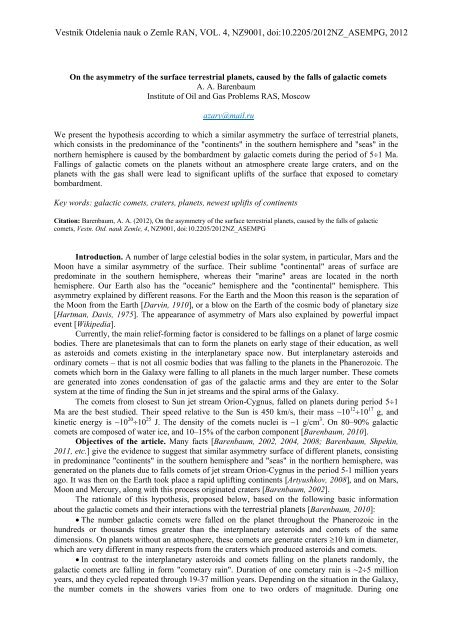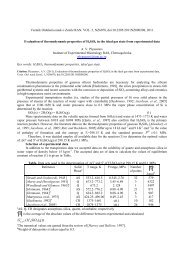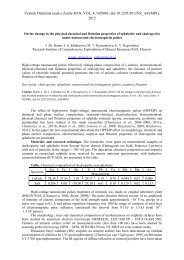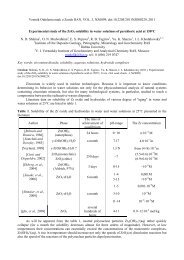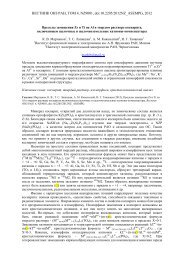On the asymmetry of the surface terrestrial planets, caused by the ...
On the asymmetry of the surface terrestrial planets, caused by the ...
On the asymmetry of the surface terrestrial planets, caused by the ...
Create successful ePaper yourself
Turn your PDF publications into a flip-book with our unique Google optimized e-Paper software.
Vestnik Otdelenia nauk o Zemle RAN, VOL. 4, NZ9001, doi:10.2205/2012NZ_ASEMPG, 2012<strong>On</strong> <strong>the</strong> <strong>asymmetry</strong> <strong>of</strong> <strong>the</strong> <strong>surface</strong> <strong>terrestrial</strong> <strong>planets</strong>, <strong>caused</strong> <strong>by</strong> <strong>the</strong> falls <strong>of</strong> galactic cometsA. A. BarenbaumInstitute <strong>of</strong> Oil and Gas Problems RAS, Moscowazary@mail.ruWe present <strong>the</strong> hypo<strong>the</strong>sis according to which a similar <strong>asymmetry</strong> <strong>the</strong> <strong>surface</strong> <strong>of</strong> <strong>terrestrial</strong> <strong>planets</strong>,which consists in <strong>the</strong> predominance <strong>of</strong> <strong>the</strong> "continents" in <strong>the</strong> sou<strong>the</strong>rn hemisphere and "seas" in <strong>the</strong>nor<strong>the</strong>rn hemisphere is <strong>caused</strong> <strong>by</strong> <strong>the</strong> bombardment <strong>by</strong> galactic comets during <strong>the</strong> period <strong>of</strong> 5÷1 Ma.Fallings <strong>of</strong> galactic comets on <strong>the</strong> <strong>planets</strong> without an atmosphere create large craters, and on <strong>the</strong><strong>planets</strong> with <strong>the</strong> gas shall were lead to significant uplifts <strong>of</strong> <strong>the</strong> <strong>surface</strong> that exposed to cometarybombardment.Key words: galactic comets, craters, <strong>planets</strong>, newest uplifts <strong>of</strong> continentsCitation: Barenbaum, A. A. (2012), <strong>On</strong> <strong>the</strong> <strong>asymmetry</strong> <strong>of</strong> <strong>the</strong> <strong>surface</strong> <strong>terrestrial</strong> <strong>planets</strong>, <strong>caused</strong> <strong>by</strong> <strong>the</strong> falls <strong>of</strong> galacticcomets, Vestn. Otd. nauk Zemle, 4, NZ9001, doi:10.2205/2012NZ_ASEMPGIntroduction. A number <strong>of</strong> large celestial bodies in <strong>the</strong> solar system, in particular, Mars and <strong>the</strong>Moon have a similar <strong>asymmetry</strong> <strong>of</strong> <strong>the</strong> <strong>surface</strong>. Their sublime "continental" areas <strong>of</strong> <strong>surface</strong> arepredominate in <strong>the</strong> sou<strong>the</strong>rn hemisphere, whereas <strong>the</strong>ir "marine" areas are located in <strong>the</strong> northhemisphere. Our Earth also has <strong>the</strong> "oceanic" hemisphere and <strong>the</strong> "continental" hemisphere. This<strong>asymmetry</strong> explained <strong>by</strong> different reasons. For <strong>the</strong> Earth and <strong>the</strong> Moon this reason is <strong>the</strong> separation <strong>of</strong><strong>the</strong> Moon from <strong>the</strong> Earth [Darvin, 1910], or a blow on <strong>the</strong> Earth <strong>of</strong> <strong>the</strong> cosmic body <strong>of</strong> planetary size[Hartman, Davis, 1975]. The appearance <strong>of</strong> <strong>asymmetry</strong> <strong>of</strong> Mars also explained <strong>by</strong> powerful impactevent [Wikipedia].Currently, <strong>the</strong> main relief-forming factor is considered to be fallings on a planet <strong>of</strong> large cosmicbodies. There are planetesimals that can to form <strong>the</strong> <strong>planets</strong> on early stage <strong>of</strong> <strong>the</strong>ir education, as wellas asteroids and comets existing in <strong>the</strong> interplanetary space now. But interplanetary asteroids andordinary comets – that is not all cosmic bodies that was falling to <strong>the</strong> <strong>planets</strong> in <strong>the</strong> Phanerozoic. Thecomets which born in <strong>the</strong> Galaxy were falling to all <strong>planets</strong> in <strong>the</strong> much larger number. These cometsare generated into zones condensation <strong>of</strong> gas <strong>of</strong> <strong>the</strong> galactic arms and <strong>the</strong>y are enter to <strong>the</strong> Solarsystem at <strong>the</strong> time <strong>of</strong> finding <strong>the</strong> Sun in jet streams and <strong>the</strong> spiral arms <strong>of</strong> <strong>the</strong> Galaxy.The comets from closest to Sun jet stream Orion-Cygnus, falled on <strong>planets</strong> during period 5÷1Ma are <strong>the</strong> best studied. Their speed relative to <strong>the</strong> Sun is 450 km/s, <strong>the</strong>ir mass ~10 12 ÷10 17 g, andkinetic energy is ~10 20 ÷10 25 J. The density <strong>of</strong> <strong>the</strong> comets nuclei is ~1 g/cm 3 . <strong>On</strong> 80–90% galacticcomets are composed <strong>of</strong> water ice, and 10–15% <strong>of</strong> <strong>the</strong> carbon component [Barenbaum, 2010].Objectives <strong>of</strong> <strong>the</strong> article. Many facts [Barenbaum, 2002, 2004, 2008; Barenbaum, Shpekin,2011, etc.] give <strong>the</strong> evidence to suggest that similar <strong>asymmetry</strong> <strong>surface</strong> <strong>of</strong> different <strong>planets</strong>, consistingin predominance "continents" in <strong>the</strong> sou<strong>the</strong>rn hemisphere and "seas" in <strong>the</strong> nor<strong>the</strong>rn hemisphere, wasgenerated on <strong>the</strong> <strong>planets</strong> due to falls comets <strong>of</strong> jet stream Orion-Cygnus in <strong>the</strong> period 5-1 million yearsago. It was <strong>the</strong>n on <strong>the</strong> Earth took place a rapid uplifting continents [Artyushkov, 2008], and on Mars,Moon and Mercury, along with this process originated craters [Barenbaum, 2002].The rationale <strong>of</strong> this hypo<strong>the</strong>sis, proposed below, based on <strong>the</strong> following basic informationabout <strong>the</strong> galactic comets and <strong>the</strong>ir interactions with <strong>the</strong> <strong>terrestrial</strong> <strong>planets</strong> [Barenbaum, 2010]:• The number galactic comets were falled on <strong>the</strong> planet throughout <strong>the</strong> Phanerozoic in <strong>the</strong>hundreds or thousands times greater than <strong>the</strong> interplanetary asteroids and comets <strong>of</strong> <strong>the</strong> samedimensions. <strong>On</strong> <strong>planets</strong> without an atmosphere, <strong>the</strong>se comets are generate craters ≥10 km in diameter,which are very different in many respects from <strong>the</strong> craters which produced asteroids and comets.• In contrast to <strong>the</strong> interplanetary asteroids and comets falling on <strong>the</strong> <strong>planets</strong> randomly, <strong>the</strong>galactic comets are falling in form "cometary rain". Duration <strong>of</strong> one cometary rain is ~2÷5 millionyears, and <strong>the</strong>y cycled repeated through 19-37 million years. Depending on <strong>the</strong> situation in <strong>the</strong> Galaxy,<strong>the</strong> number comets in <strong>the</strong> showers varies from one to two orders <strong>of</strong> magnitude. During one
BARENBAUM ET AL: ON THE ASYMMETRY OF THE SURFACEbombardment on <strong>the</strong> Earth may fall 10 4 ÷10 6 comets. The latest cometary rain took place 5÷1 Ma andhas been a relatively "weak." According to our estimates for this time on <strong>the</strong> <strong>surface</strong> <strong>of</strong> <strong>planets</strong> witharea 100×100 km 2 could fall 3–5 galactic comets.• Such density fallings <strong>of</strong> galactic comets, however, is sufficient to completely saturate <strong>the</strong><strong>surface</strong> <strong>by</strong> craters with diameter 10÷200 km. Limit saturated <strong>by</strong> <strong>the</strong>se craters <strong>the</strong> <strong>surface</strong>s <strong>of</strong> <strong>the</strong> Moon,Mercury and Mars <strong>the</strong>oretically is about ∼100 craters in <strong>the</strong> area <strong>of</strong> 1 million km 2 . Calculations showthat in saturation state funnels <strong>of</strong> craters occupy 50% all <strong>surface</strong>.• An important factor causing <strong>the</strong> anisotropy <strong>of</strong> <strong>planets</strong> <strong>surface</strong>, is <strong>the</strong> obliquity <strong>of</strong> <strong>the</strong> planeecliptic at an angle <strong>of</strong> 62° to <strong>the</strong> plane <strong>of</strong> <strong>the</strong> Galaxy in which <strong>the</strong> comets moved. The availableevidence suggests that <strong>the</strong> last time <strong>the</strong> galactic comets mainly fell on <strong>the</strong> sou<strong>the</strong>rn hemisphere <strong>planets</strong>,<strong>the</strong> axis rotation <strong>of</strong> which is perpendicular to <strong>the</strong> ecliptic or deviates from this direction weakly.Among <strong>the</strong>m <strong>the</strong> Earth, Mars, and Mercury, as well as <strong>the</strong> Moon.• The presence gaseous envelope at planet radically changes <strong>the</strong> physics <strong>of</strong> <strong>the</strong> interactiongalactic comets with <strong>the</strong> <strong>planets</strong>. In <strong>the</strong> atmosphere <strong>of</strong> <strong>the</strong> Earth galactic comets are completelydestroyed, forming hypersonic jet consisting <strong>of</strong> evaporated cometary material and shock heated air.Reaching <strong>the</strong> <strong>surface</strong>, this jet does not create a crater and uses <strong>the</strong> most part its energy to heat ~100-200 km layer <strong>of</strong> rocks under <strong>the</strong> place <strong>of</strong> comet impact. In <strong>the</strong> future this <strong>the</strong>rmal energy is released indifferent tectonomagmatic processes. In <strong>the</strong> oceans and seas this are, above all, <strong>the</strong> outpouring <strong>of</strong> lavato <strong>the</strong> bottom and <strong>the</strong> formation seamounts, and on <strong>the</strong> continents are <strong>the</strong> uplifting <strong>surface</strong> and <strong>the</strong>formation intrusions [Barenbaum, 2008, 2011].• In <strong>the</strong> atmosphere <strong>of</strong> Mars, to 100 times less dense than at <strong>the</strong> Earth, <strong>the</strong> nuclei <strong>of</strong> galacticcomets partially evaporate, which leads simultaneously to two effects: to lifting continental <strong>surface</strong>and to appearance <strong>of</strong> craters on it. At this, however, craters on Mars turn out systematically smaller indiameter than for example on <strong>the</strong> Moon and Mercury, which have not <strong>the</strong> gas shells.We illustrate this conclusions using relevant evidence.Factual data and its discussion. In Fig. 1a shows a relief map <strong>of</strong> Mars, and in Fig. 1b shows<strong>the</strong> area occupied <strong>by</strong> funnels craters on both sides <strong>of</strong> <strong>the</strong> border in Fig. 1a.90Marine hemisphereaσ0.6b4004090180 160 120 80Continental hemisphere40 0320 280 240 200 1800.50.40.30.20.10-90 -60 -30 0 +60 +90Fig. 1. a) The asymmetric structure <strong>of</strong> <strong>the</strong> <strong>surface</strong> <strong>of</strong> Mars [Shaded relief map <strong>of</strong> Mars, 1972]. Lineshows <strong>the</strong> boundary between <strong>the</strong> "maritime" and <strong>the</strong> "continental" hemispheres <strong>of</strong> Mars, separating<strong>the</strong> regions with different density <strong>of</strong> large craters [Kazimirov, 1977]; b) Calculation <strong>of</strong> <strong>the</strong> share<strong>surface</strong> <strong>of</strong> Mars under craters with a diameter ≥ 10 km in <strong>the</strong> bands <strong>of</strong> latitude 30° on both sides <strong>of</strong><strong>the</strong> border [Barenbaum, 2002], dashed line – <strong>the</strong> <strong>the</strong>oretical limit saturation <strong>of</strong> <strong>the</strong> <strong>surface</strong> <strong>by</strong> craterswith diameter ≥ 10 kmIn Fig. 1a schematically shown <strong>surface</strong> <strong>of</strong> <strong>the</strong> Mars, which is segregated <strong>the</strong> tectonic boundaryinto two hemispheres: <strong>the</strong> sou<strong>the</strong>astern <strong>of</strong> tectonically passive – "continental" and <strong>the</strong> northwesterntectonically active – "maritime". Continental hemisphere is known to be elevated above <strong>the</strong> maritime<strong>by</strong> 2–6 km, and completely covered with large craters, whereas <strong>surface</strong> <strong>of</strong> <strong>the</strong> maritime hemisphere ispresented <strong>of</strong> smooth plain with few amount <strong>of</strong> craters. The boundary between <strong>the</strong> hemispheres also isunusual. She is obtained as <strong>the</strong> trace <strong>of</strong> <strong>the</strong> cross section <strong>of</strong> a spherical <strong>surface</strong> <strong>of</strong> Mars <strong>by</strong> <strong>the</strong> planeinclined to his rotation axis at an angle <strong>of</strong> 35° [Kazimirov, 1977].In Fig. 1b shown calculated according to data [Kazimirov et al, 1980] portion <strong>of</strong> <strong>the</strong> <strong>surface</strong>Mars covered <strong>by</strong> craters on both sides <strong>of</strong> his tectonic boundary. From <strong>the</strong> calculations follows that <strong>the</strong>continental hemisphere <strong>of</strong> Mars is maximal saturated <strong>by</strong> craters. Moreover if in this hemisphere
BARENBAUM ET AL: ON THE ASYMMETRY OF THE SURFACE<strong>the</strong> volume <strong>of</strong> a cube evenly. We calculated heating temperature and <strong>the</strong> corresponding to thistemperature <strong>the</strong> elongation edges <strong>of</strong> a cube. It is shown that <strong>by</strong> heating <strong>of</strong> <strong>the</strong> column rocks <strong>by</strong> length100 km for every 100°, it elevates Earth's <strong>surface</strong> <strong>by</strong> 300 m. But if for small comets <strong>the</strong>se effects aresmall <strong>the</strong> comet with <strong>the</strong> energy <strong>of</strong> ~10 25 J heats <strong>the</strong> substance more than 1000° that leads to acomplete melting <strong>of</strong> <strong>the</strong> rocks in <strong>the</strong> volume 10 6 km 3 .Comets such energies, however, is very small. At <strong>the</strong> time <strong>of</strong> last bombardment <strong>the</strong>ir probabilityfalling to area 100×100 km 2 is order <strong>of</strong> ~10 -3 . For comets medium-energy ~10 22 –10 24 J likelihood <strong>of</strong>falls on <strong>the</strong> same area are much higher. Such comets heat <strong>the</strong> rocks at hundreds <strong>of</strong> degrees, and <strong>the</strong>yare able to provide lift <strong>of</strong> Earth's <strong>surface</strong> for miles.These estimates are well consistent with <strong>the</strong> observed height <strong>of</strong> newest uplifts as well as with<strong>the</strong> degree <strong>of</strong> heating <strong>of</strong> underlying rocks. Clearly, that fallings <strong>of</strong> galactic comets can to producehighly non-uniform heating <strong>the</strong> rocks <strong>of</strong> <strong>the</strong> lithosphere beneath <strong>the</strong> continents in <strong>the</strong> lateral plane, andas in depth. Undoubtedly and <strong>the</strong> fact that additional heating <strong>of</strong> rocks at <strong>the</strong> lower boundary <strong>of</strong> <strong>the</strong>lithosphere in a state close to <strong>the</strong> liquids, inevitably leads to <strong>the</strong> melting and to chemicaltransformation <strong>of</strong> minerals in <strong>the</strong> processes <strong>of</strong> eclogitization.Thus we can assert <strong>the</strong> fallings <strong>of</strong> galactic comets leads to origin at <strong>the</strong> base <strong>of</strong> <strong>the</strong> lithosphere<strong>the</strong> thick layer <strong>of</strong> rocks, which may be nonuniformly heated and partially molten. This layer we canjustifiably be named as <strong>the</strong> as<strong>the</strong>nosphere. The existence <strong>of</strong> <strong>the</strong> as<strong>the</strong>nosphere it is characteristicphenomenon not only for <strong>the</strong> Earth but as well as for all <strong>terrestrial</strong> <strong>planets</strong>. The appearance <strong>of</strong> thislayer under <strong>the</strong> Earth's continents leads to a significant raise <strong>of</strong> <strong>the</strong>ir <strong>surface</strong>, and under <strong>the</strong> oceansbottom leads to <strong>the</strong> intense outpouring <strong>of</strong> lava, especially in <strong>the</strong> zones <strong>of</strong> mid-ocean ridges.Summary and conclusions1. The modern predominance <strong>of</strong> sublime "continental" regions <strong>of</strong> <strong>the</strong> <strong>surface</strong> <strong>planets</strong> in <strong>the</strong>sou<strong>the</strong>rn hemisphere and <strong>of</strong> low "marine" regions in <strong>the</strong> nor<strong>the</strong>rn hemisphere, it is mainly consequence<strong>the</strong> bombardment <strong>of</strong> <strong>the</strong> <strong>planets</strong> <strong>by</strong> <strong>the</strong> galactic comets in period 5÷1 Ma.2. Fall galactic comets are a general cause <strong>of</strong> <strong>the</strong> raise considerable parts <strong>of</strong> <strong>the</strong> planet <strong>surface</strong>and appearance <strong>of</strong> large impact craters on <strong>the</strong> same <strong>surface</strong>. The <strong>surface</strong> rises on <strong>planets</strong> with denseatmosphere, whereas <strong>the</strong> craters arise on <strong>the</strong> <strong>planets</strong> without <strong>the</strong> atmosphere. <strong>On</strong> <strong>the</strong> Mars, whichpossesses a rarefied gas environment this two processes occur simultaneously.ReferencesArtyushkov, E. V. (2008). Newest uplifts <strong>of</strong> crystal on <strong>the</strong> continents as a consequence <strong>of</strong> rapids<strong>of</strong>tening <strong>of</strong> <strong>the</strong> lithosphere mantle and <strong>of</strong> its replacement <strong>by</strong> as<strong>the</strong>nosphere, General and regionalproblems <strong>of</strong> tectonics and geodynamics, v.1. Moscow: GEOS, p. 31–34 (in Russian).Barenbaum, A. A. (2002). Galaxy, Solar system, Earth. Subordinated processes and evolution,Moscow: GEOS, 393 p (in Russian).Barenbaum, A. A. (2004). <strong>On</strong> a one particularity <strong>of</strong> as<strong>the</strong>nosphere <strong>of</strong> <strong>the</strong> Mars, VestnikOtdelenia nauk o Zemle RAN, №1 (22)′2004 URL: http://www.scgis.ru/russian/cp1251/h_dgggms/1-2004/informbul-1/planet-14.pdfBarenbaum, A. A. (2008). Processes in <strong>the</strong> Earth crust and upper mantle: problems <strong>of</strong> <strong>the</strong>mountain building and <strong>the</strong> newest <strong>terrestrial</strong> crust elevation, Connection between <strong>surface</strong> structures <strong>of</strong><strong>the</strong> <strong>terrestrial</strong> crust with deep-seated ones, Materials XIV Intern. Conference. Petrozavodsk, KarelianScience Center RAS, P.1, p. 43-47 (in Russian).Barenbaum, A. A. (2010). Galaxycentric paradigm in geology and astronomy, Moscow: PHLIBROKOM, 544 p (in Russian).Barenbaum, A. A. (2011). Tectonomagmatic processes in <strong>the</strong> oceans and on <strong>the</strong> continents as<strong>the</strong> indicators fallings <strong>of</strong> galactic comets. Internal, Conference dedicated memory V. E. Khain: Themodern state <strong>of</strong> <strong>the</strong> Earth sciences, Moscow: MGU. http://khain 2011.web.ru. p. 166–171 (inRussian).Barenbaum, A. A. (2012) <strong>On</strong> <strong>the</strong> origin <strong>of</strong> newest uplifts <strong>of</strong> <strong>the</strong> Earth crust: a new formulation<strong>of</strong> <strong>the</strong> problems <strong>of</strong> global geodynamics (in press).Barenbaum, A. A., V. E. Hain, N. A. Yasamanov (2004). Large-scale tectonic cycle: an analysisfrom <strong>the</strong> standpoint <strong>of</strong> <strong>the</strong> galactic concept, Vestnik MGU, Ser.4, Geology, №3, p. 3–16.Barenbaum, A. A., M. I. Shpekin (2011). <strong>On</strong> <strong>the</strong> age <strong>of</strong> <strong>the</strong> lunar <strong>surface</strong>, Vestnik Otdelenianauk o Zemle RAN, v.3, NZ6011, doi:10.2205/2011NZ000141.Barkin, Yu. V. (2007). Mechanism <strong>of</strong> increase in mean sea level and <strong>the</strong> decision <strong>of</strong> "attributionproblem", Geology <strong>of</strong> <strong>the</strong> seas and oceans, v. IV, Moscow: GEOS, p. 21–23 (in Russian).
BARENBAUM ET AL: ON THE ASYMMETRY OF THE SURFACEBozhko, N. A. (2003). Super-continental cyclicity in <strong>the</strong> tectonic development <strong>of</strong> <strong>the</strong>lithosphere, Tectonics and geodynamics <strong>of</strong> <strong>the</strong> continental lithosphere, v.1, Moscow: GEOS, p. 56–60(in Russian).Chumakov, N. M. (2001). Periodicity <strong>of</strong> main glacial events and <strong>the</strong>ir correlation with <strong>the</strong>endogenous activity <strong>of</strong> <strong>the</strong> Earth, Doklady Akad. Nauk, v. 378, №5, p. 656–659 (in Russian).Darvin, G. H. (1910) Scientific Papers. V.III. Cambrige.Hartman, W. K., Davis, D. R. (1975) Satellite-sized planetesimals and lunar origin. Icarus.V.24. p. 504–515.Kazimirov, D. A. (1977). De-symmetry <strong>of</strong> <strong>terrestrial</strong> <strong>planets</strong> and satellites and <strong>the</strong> main phase <strong>of</strong><strong>the</strong>ir development. Questions <strong>of</strong> planetary tectonogenesis. Pr. GIN. Issue 1. Moscow. p. 23–66 (inRussian).Kazimirov, D. A., B. D. Sitnikov, G. A. Poroshkova and o<strong>the</strong>rs (1980). Density distribution <strong>of</strong>craters on <strong>the</strong> Moon, Mercury and Mars. Preprint GIN-GAISH (in Russian).Khain, V. E. (2000). Large-scale cyclicity in <strong>the</strong> tectonic history <strong>of</strong> <strong>the</strong> Earth and its possiblecauses. Geotektonika. №6. p. 3–14 (in Russian).Shaded relief map <strong>of</strong> Mars (1972). 1:25000000.Voronov A., R. G. Strom, M. Garkis (1986). Interpretation <strong>of</strong> crater chronicles: from Mercuryto Ganymede and Callisto. Satellites <strong>of</strong> Jupiter. Part 2. Moscow: Mir, p. 5–48 (in Russian).Wikipedia. http://ru.wikipedia.org/wiki/Mars (planet).


